신생아의 피부 관리, Skin cares for newborn infants
- 정상적으로 신생아의 피부가 조금 쪼글쪼글할 수 있다.
- 자궁 내 태아 성장지연이 있는 신생아에게 또 과숙 신생아에게 이런 형의 피부가 더 잘 생길 수 있다.
- 갓 태어난 아기들의 피부는 양수에 젖어 미끈미끈하고 하얀 크림 비슷한 태지가 피부의 일부나 전체피부에 묻어 있을 수 있다.
- 태지가 특히 겨드랑이나 가랑이에 더 많이 묻어 있을 수 있다.
- 갓 태어난 아기들의 피부는 부드럽고 섬세하고 아름답다.
- 피부의 색은 인종에 따라, 각 아기에 따라 차이가 난다.
- 출생 후 처음 몇 시간 동안 갓 태어난 아기의 피부의 색은 붉거나 핑크 색을 뛰는 것이 보통이다.
- 물론 흑인 신생아들의 피부색은 검다.
- 갓 태어난 아기들의 피부는 정상적으로 쪼글쪼글할 수 있고 피부층의 각질층이 얇게 벗겨질 수 있다.
- 쪼글쪼글하고 벗겨진 피부는 생후 2∼3주 정도 지나면 정상적으로 돌아가고 고와진다. p.00 왜 피부가 쪼글쪼글하고 얇게 벗겨지나요? 참조.
- 대부분의 신생 남아들의 음낭과 신생 여아들의 대소음순의 피부색은 흑갈색이다.
- 가는 배안 솜털이 특히 어깨, 등, 팔, 다리에 정상적으로 나 있을 수 있다.
- 이런 배안 솜털은 생후 4개월 경 거의 다 없어지고 배안 솜털은 새 체모로 바꿔지는 것이 보통이다.
- 실내 온도가 아주 낮아서 추면 갓 태어난 아기들의 체온이 떨어져 손발이 차고 파랗게 될 수 있다.
- 이렇게 손발에 생긴 파란 증상 징후를 선단 청색증, 말단 청색증 또는 선단 자람증이라고 한다.
- 실내의 온도를 적절히 높여 조절하고 아기를 잘 싸서 보온해 주면 파랗고 찬 손발이 정상으로 곧 돌아간다.
- 1∼2개 파란 모반이 엉덩이, 어깨, 등, 얼굴, 팔, 다리, 또는 안구 등에 나 있을 수 있다. 이런 파란 모반을 몽고반점이라고 한다(부모도 반의사가 되어야한다-소아가정간호 백과-제 17권 소아 피부 질환-몽고반점 참조).
- 여러 개의 몽고반점들이 신체 피부 여러 부위에 나 있을 수 있다.
- 대부분의 몽고반점은 생후 2세 이전에 저절로 없어진다.
- 그러나 드물게는 7세경까지 그대로 남아 있을 수 있다.

사진 2-256. 신생아의 정상 피부색
Copyright ⓒ 2012 John Sangwon Lee, MD., FAAP
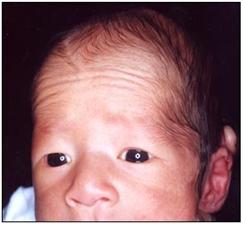
사진 2-257. 과숙 신생아의 정상 피부이다. 이마에 쪼글쪼글 주름살이 잡혀있다.
Copyright ⓒ 2012 John Sangwon Lee, MD., FAAP

사진 2-258. 몽고 반점이 엉덩이의 바로 위 중앙 부위에 파랗게 나 있다. 아무 치료도 없이 관찰만 해도 된다.
Copyright ⓒ 2012 John Sangwon Lee, MD., FAAP
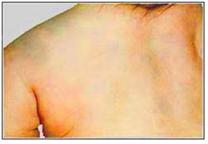
사진 2-259. 왼쪽 어깨에 난 몽고 반점
Copyright ⓒ 2012 John Sangwon Lee, MD., FAAP
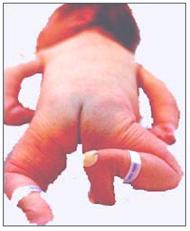
사진 2-260. 몽고 반점이 엉덩이 바로 위 부위에 파랗게 나 있다.
Copyright ⓒ 2012 John Sangwon Lee, MD., FAAP
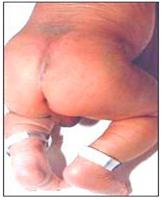
사진 2-261.몽고 반점이 엉덩이 바로 위 부위에 파랗게 나 있다.
Copyright ⓒ 2012 John Sangwon Lee, MD., FAAP
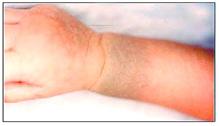
사진 2-262. 앞 팔에 난 몽고반점이다. 주로 아시아계 신생아들에게서 볼 수 있지만, 약 5%의 백인계 신생아들에게서도 볼 수 있다.
Copyright ⓒ 2012 John Sangwon Lee, MD., FAAP
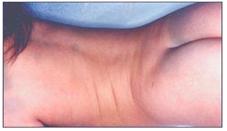
사진 2-263. 몽고반점이 어깨, 등과 엉덩이에 여러 개 나 있다.
Copyright ⓒ 2012 John Sangwon Lee, MD ., FAAP

사진 2-264. 신생아의 발목과 발의 각질층의 표피가 얇게 벗겨졌다.
Copyright ⓒ 2012 John Sangwon Lee, MD,., FAAP
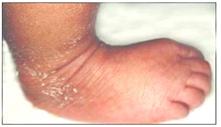
사진 2-265. 신생아의 발목과 발의 각질층 의 표피가 얇게 벗겨졌다.
Copyright ⓒ 2012 John Sangwon Lee, MD., FAAP

사진 2-266. 임신 34주에 제왕절개 수술 분만으로 태어난 미숙 신생아의 피부가 하얀 태지로 덮혀 있다.
Copyright ⓒ 2012 John Sangwon Lee, MD., FAAP
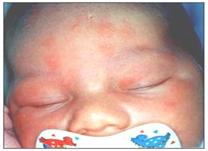
사진 2-267. 얼굴에 난 중독성 홍반이다. 아무 치료 없이 자연히 없어진다.
Copyright ⓒ 2012 John Sangwon Lee, MD., FAAP
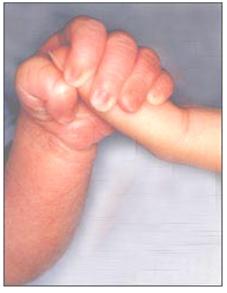
사진 2-268. 엄마와 갓 태어난 아기 사이에 생긴 신체적 접촉사랑. 갓 태어난 신생아가 엄마의 손가락을 꼭 잡고 있다. 갓 태어난 아기의 피부의 색은 정상적으로 좀 붉다.
Copyright ⓒ 2012 John Sangwon Lee, MD., FAAP

사진 2-269. 말단(선단) 청색증으로 갓 태어난 아기의 왼 손이 파랗다.
Copyright ⓒ 2012 John Sangwon Lee, MD., FAAP
Skin cares for newborn infants
• Normally, newborns’ skin may be slightly wrinkled.
• Newborns with intrauterine fetal growth retardation and premature newborns are more likely to develop this type of skin.
• Newborn babies’ skin is wet with amniotic fluid, so the white, creamy vernix may be on some or all of the skin.
• Vernix may be more abundant, especially in the armpits or crotch.
• The skin of newborn babies is soft, delicate, and beautiful.
• Skin color varies from race to race and from baby to baby.
• During the first few hours after birth, it is normal for a newborn baby’s skin to glow red or pink.
• Of course, black newborns have dark skin.
• Newborn babies’ skin may normally wrinkle, and the skin layer’s stratum corneum may peel off.
• The wrinkled and peeled skin returns to normal after 2 to 3 weeks after birth and becomes smooth.
Why does my skin wrinkle and peel off thinly? Reference.
• The skin color of the scrotum of most newborn boys and the labia majora of newborn girls is dark brown.
• There may be a normal amount of fine ventral fluff, especially on the shoulders, back, arms, and legs.
• Almost all of these belly hairs disappear around 4 months of age, and it is normal for the belly hairs to be replaced with new body hair.
• If the temperature inside the room is very low, the body temperature of newborn babies drops and then their hands and feet become cold and blue.
• These blue signs of symptoms on the limbs are called acrocyanosis.
• If the temperature of the room is properly raised and controlled, and the baby is well wrapped and kept warm, the blue and cold limbs will return to normal soon.
• One or two blue birthmarks may be on the buttocks, shoulders, back, face, arms, legs, or eyes. These blue nevi are called Mongolian spots (Parents must also become at least half doctors-Volume 17 Pediatric skin diseases-Mongolian spots).
• Multiple Mongolian spots may be present on various parts of the body’s skin.
• Most Mongolian spots go away on their own before 2 years of age.
• Rarely may remain until around the age of 7 years.

Picture 2-256. Normal skin color in newborns. Copyright ⓒ 2012 John Sangwon Lee, MD., FAAP

Picture 2-257. This is the normal skin of a premature newborn. There are wrinkles on the forehead. Copyright ⓒ 2012 John Sangwon Lee, MD., FAAP

Picture 2-258. Mongolian spots are blue in the center just above the buttocks. It can be observed without any treatment. Copyright ⓒ 2012 John Sangwon Lee, MD., FAAP

Picture 2-259. Mongolian patch on left shoulder.Copyright ⓒ 2012 John Sangwon Lee, MD., FAAP

Photo 2-260. Mongolian spots are blue in the area just above the buttocks. Copyright ⓒ 2012 John Sangwon Lee, MD., FAAP

Picture 2-261. Mongolian spots are blue in the area just above the buttocks. Copyright ⓒ 2012 John Sangwon Lee, MD., FAAP

Photo 2-262.A newborn has Mongolian spots on his forearm. It is mainly seen in newborns of Asian descent, but can also be seen in about 5% of newborns of Caucasian descent. Copyright ⓒ 2012 John Sangwon Lee, MD., FAAP

Photo 2-263. There are several Mongolian spots on the shoulders, back, and buttocks. Copyright ⓒ 2012 John Sangwon Lee, MD ., FAAP

Picture 2-264. The epidermis of the stratum corneum of the newborn’s ankles and feet was peeled off thinly. Copyright ⓒ 2012 John Sangwon Lee, MD,., FAAP

Picture 2-265. The epidermis of the stratum corneum of the newborn’s ankles and feet was thinly peeled off. Copyright ⓒ 2012 John Sangwon Lee, MD., FAAP

Picture 2-266. The skin of a premature newborn born by cesarean section at 34 weeks gestation is covered with white vernix. Copyright ⓒ 2012 John Sangwon Lee, MD., FAAP

Picture 2-267. Addictive erythema on my face. It goes away spontaneously without any treatment. Copyright ⓒ 2012 John Sangwon Lee, MD., FAAP

Picture 2-268. Physical contact love between mother and newborn baby. Newborn newborn baby holding her mom’s finger. The color of the skin of a newborn baby is normally a little red. Copyright ⓒ 2012 John Sangwon Lee, MD., FAAP

Photo 2-269. The left hand of a newborn baby with distal acro cyanosis is blue. Copyright ⓒ 2012 John Sangwon Lee, MD., FAAP
출처 및 참조문헌
- Nelson Textbook of Pediatrics 22ND Ed
- The Harriet Lane Handbook 22ND Ed
- Growth and development of the children
- www.drleepediatrics.com 제1권 소아청소년 응급 의료
- www.drleepediatrics.com 제2권 소아청소년 예방
- www.drleepediatrics.com 제3권 소아청소년 성장 발육 육아
- www.drleepediatrics.com 제4권 모유,모유수유, 이유
- www.drleepediatrics.com 제5권 인공영양, 우유, 이유식, 비타민, 미네랄, 단백질, 탄수화물, 지방
- www.drleepediatrics.com 제6권 신생아 성장 발육 육아 질병
- www.drleepediatrics.com제7권 소아청소년 감염병
- www.drleepediatrics.com제8권 소아청소년 호흡기 질환
- www.drleepediatrics.com제9권 소아청소년 소화기 질환
- www.drleepediatrics.com제10권. 소아청소년 신장 비뇨 생식기 질환
- www.drleepediatrics.com제11권. 소아청소년 심장 혈관계 질환
- www.drleepediatrics.com제12권. 소아청소년 신경 정신 질환, 행동 수면 문제
- www.drleepediatrics.com제13권. 소아청소년 혈액, 림프, 종양 질환
- www.drleepediatrics.com제14권. 소아청소년 내분비, 유전, 염색체, 대사, 희귀병
- www.drleepediatrics.com제15권. 소아청소년 알레르기, 자가 면역질환
- www.drleepediatrics.com제16권. 소아청소년 정형외과 질환
- www.drleepediatrics.com제17권. 소아청소년 피부 질환
- www.drleepediatrics.com제18권. 소아청소년 이비인후(귀 코 인두 후두) 질환
- www.drleepediatrics.com제19권. 소아청소년 안과 (눈)질환
- www.drleepediatrics.com 제20권 소아청소년 이 (치아)질환
- www.drleepediatrics.com 제21권 소아청소년 가정 학교 간호
- www.drleepediatrics.com 제22권 아들 딸 이렇게 사랑해 키우세요
- www.drleepediatrics.com 제23권 사춘기 아이들의 성장 발육 질병
- www.drleepediatrics.com 제24권 소아청소년 성교육
- www.drleepediatrics.com 제25권 임신, 분만, 출산, 신생아 돌보기
- Red book 29th-31st edition 2021
- Nelson Text Book of Pediatrics 19th- 21st Edition
- The Johns Hopkins Hospital, The Harriet Lane Handbook, 22nd edition
- 응급환자관리 정담미디어
-
소아가정간호백과–부모도 반의사가 되어야 한다, 이상원
-
Neonatal Resuscitation American heart Association
-
Neonatology Jeffrey J.Pomerance, C. Joan Richardson
-
Pediatric Resuscitation Pediatric Clinics of North America, Stephen M. Schexnayder, M.D.
-
Pediatric Critical Care, Pediatric Clinics of North America, James P. Orlowski, M.D.
-
Preparation for Birth. Beverly Savage and Dianna Smith
-
Infectious disease of children, Saul Krugman, Samuel L Katz, Ann A. Gershon, Catherine Wilfert
- 소아과학 대한교과서
- Other
|
Copyright ⓒ 2015 John Sangwon Lee, MD., FAAP 미국 소아과 전문의, 한국 소아청소년과 전문의 이상원 저 “부모도 반의사가 되어야 한다”-내용은 여러분들의 의사로부터 얻은 정보와 진료를 대신할 수 없습니다. “The information contained in this publication should not be used as a substitute for the medical care and advice of your doctor. There may be variations in treatment that your doctor may recommend based on individual facts and circumstances. “Parental education is the best medicine.” |